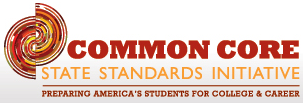
US Education Standards
All the education standards provide an important nationwide concenus of domain experts view on:
Important facts to remember with in a domain.
How to think and make sense domain information.
How to research and interpret domain information.
How to communicate domain information.
How to apply a range of critical thinking skills and strategies to the domain.
4MyLearn is actively involved in these thinking-based standards.
Math and English Arts: Common Core State Standards (CCSS)

National Governors Association (NGA) and the Council of Chief State School Officers (CCSSO) have led the development of the Common Core State Standards for math and english arts. Adopted by 45 states to date, the CCSS are organized into key content strands and articulated across all years of schooling and in most cases replace the existing state content standards. The initiative has been state-based and coordinated by the NGA and the CCSSO. Designed by teachers, administrators, and content experts, the CCSS are intended to prepare K-12 students for college and the workplace. More on CCSS Math.; More on CCSS ELA.
Science: Next Generation Science Standards

Science: Next Generation Science Standards, was released April 9, 2013 as a standard for K-12 science education. It identifies science and engineering practices and content that all K-12 students should master in order to be fully prepared for college, careers and citizenship. The NGSS were built upon a vision for science education established by the Framework for K-12 Science Education, published by the National Academies' National Research Council in 2011. Included are Earth Space Science, Life Science, and Physical Science disciplines, along with Crosscutting Concepts and the principles for Understanding Nature of Science. 4MyLearn has been involved in its review. Here is our summary of the Next Generation Science Standards focus areas.
Social Studies: College, Career, and Civic Life (C3) Framework for Social Studies State Standards

Over the 3 1/2 years, a consortium of states worked to develop The College, Career, and Civic Life (C3) Framework for Social Studies State Standards. It was Sept 2013. This state-led effort was facilitated by the Council of Chief State School Officers (CCSSO) and supported by 15 professional organizations, including National Council for the Social Studies, representing four core social studies content areas: civics, economics, geography, and history. 4MyLearn has been involved in its review. Here is our summary of the C3 Framework for Social Studies State Standards focus areas.
Arts
The National Coalition for Core Arts Standards is leading the February 28 2014 review of the National Standards for Arts Education. National Standards for Arts Education: What Every Young American Should Know and Be Able to Do in the Arts. It was the work of the Consortium of National Arts Education Associations, which included representatives from the American Alliance for Theatre and Education, the National Art Education Association, the Music Educators National Conference, and the National Dance Association. The published standards are discipline-specific to dance, music, theater, and the visual arts. From six to nine standards are given in each field, and each standard is articulated across sets of grades: K~4, 5-8, and 9-12.
World Languages
The American Council on the Teaching of Foreign Languages (ACTFL) published an alignment of the National Standards for Learning Languages with the ELA Common Core State Standards.
Gifted
The National Association for Gifted Children (NAGC) has published standards for preK through Grade 12 gifted programs in seven areas. Specifically, the standards (NAGC, 1998) suggest that:
• Curriculum for the gifted learner should be differentiated and span Grades preK through 12.
• Regular classroom curricula must be adapted, modified, or replaced to meet the needs of the gifted.
• The pace of instruction must be flexible to allow for the accelerated learning of the gifted.
• Gifted students must be allowed to skip subjects and grades.
• Gifted learners must have opportunities that provide a variety of curriculum options, instructional approaches, and resources.
U.S. Department of Education believes that there are approximately 360,000 twice-exceptional (gifted students with disabilities) students in America’s schools (National Education Association, 2006). NAGC estimates that there are approximately 3 million academically gifted children in grades K-12 in the U.S - approximately 6% of the student population. No federal agency or organization formally collects statistics on these students.
It has been stated by some that the CCSS core standards are already high level so there is no more need for gifted education services. Some schools are taking this view as a cost reducing measure. The CCSS and domain standards represent a different emphasis, that specifies minimum acheivement. Many children will be prepared for and need more to remain engaged.
Special education
In December 2012 the National Council for the Accreditation of Teacher Education (NCATE) approved the initial and advanced CEC Preparation Standards for special educators. No neurobiology training requirement. Learning differences are acknowledged, but not thinking differences.
